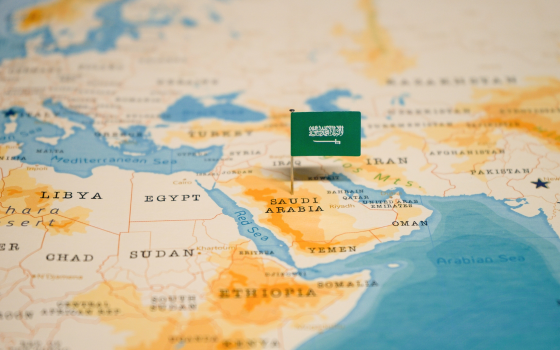17-19 JANUARY 2027
RIYADH FRONT EXHIBITION & CONFERENCE CENTER (RFECC)

While global headlines may focus elsewhere, stable conditions in much of the Middle East, particularly in the Gulf region, are allowing the paint and coatings industry to flourish. In Saudi Arabia, with a population of 33.2 million and a GDP per capita of USD 32,000 (World Bank), the market is seeing notable expansion.
According to India-based MarkNTel, Saudi Arabia’s paint market is valued at USD 1.5 billion, driven by investment in infrastructure, real estate, and large-scale development projects aligned with the country’s economic diversification plans. Christopher Sharkey, Director of Infrastructure Sales, Middle East at Danish manufacturer Hempel, noted, “The Saudi paint market has grown by 20–25% in the last 18 months,” adding that Hempel's sales have grown faster than the market. He expects a 12% annual growth rate for the next decade. The broader GCC paint market, which includes Bahrain, Kuwait, Oman, Qatar, the UAE and Saudi Arabia, is estimated at over USD 1.08 billion.
This market momentum is reflected in events like the Saudi Arabia Coatings Show, organized by The Coatings Group.
Market estimates vary slightly: the IMARC Group values Saudi Arabia’s paint and coatings sector at USD 1.55 billion in 2024, with projections reaching USD 2.1 billion by 2033. Ken Research places the current market value at USD 1.7 billion. Key manufacturers include Jazeera Paints, National Paints, Jotun, Kansai Paint, AkzoNobel, and Sherwin-Williams.
Sharkey highlighted the role of infrastructure and real estate projects, including public housing, shopping malls, and entertainment centres, in sustaining paint sales. Jazeera Paints, which produces more than 400,000 tonnes of coatings annually, also attributed sales growth to major development projects linked to Vision 2030. The company noted that rapid urbanisation and rising investments in housing and infrastructure would continue to support demand.
Prominent mega-projects driving demand include Neom, Qiddiya, and the Red Sea Project. These, alongside housing programmes aimed at increasing homeownership, are key contributors to paint and coating usage. Due to Saudi Arabia’s hot and dry climate, alongside humid conditions in coastal areas, advanced protective and aesthetic coatings are in high demand.
Transport and energy projects such as railway and renewable energy plant developments are also increasing demand for technical coatings. Additionally, growing commercial activity is fuelling demand for specialised paints, including environmentally friendly options like low-VOC products. Jazeera Paints is investing in innovative solutions including heat-reflective and bacteria-resistant coatings, as well as automotive and industrial paints with corrosion and scratch resistance.
Retail innovation is also underway. In 2024, Jazeera Paints launched a mobile app using AI and augmented reality to help consumers visualise paint choices.
According to Jones Lang LaSalle (JLL), the Saudi construction sector is valued at USD 70.33 billion and could generate USD 91.36 billion annually by 2029. Significant developments are ongoing in Riyadh, including tourism, green urban spaces, and preparations for major international events. These projects are expected to require substantial volumes of paint and coatings.
Fire-retardant intumescent paints are in growing demand, particularly for infrastructure and energy projects. Updates to building and fire codes are expected in 2025, with material certification now being handled by global third-party testing laboratories. This shift allows greater flexibility and rigour in product approval for large-scale developments.
Decorative paint sales are also benefiting from e-commerce, driven by a youthful population and widespread use of social media. Hempel has developed a strong e-commerce platform to meet this growing channel of demand.
UAE: Economic Growth and Construction Boom Fuel Paint Sector Expansion
The UAE is also experiencing strong sales growth in its paint and coatings market, supported by a vibrant economy, real estate development, and infrastructure investment. The International Monetary Fund projects 5.1% GDP growth in the UAE for 2025.
Shailu Suvarna, Manager of Infrastructure Sales for UAE and Oman at Hempel, reported steady growth over the past 18 months. He anticipates a CAGR of 5% over the next 5–8 years. Hempel estimates the UAE coatings market at nearly USD 1 billion, with the protective and marine coatings segment accounting for USD 300 million.
Residential real estate has been a major driver, particularly in Dubai. In 2024, villa and townhouse sales rose by 71%, while apartment sales increased by 42%, according to the Dubai Land Department and real estate consultancy Cavendish Maxwell. Around 243,000 new residential units are expected to be constructed by 2027.
Ongoing projects across the UAE, valued at USD 56.5 billion (ProTenders), also include infrastructure developments in transportation and energy. These are stimulating demand for protective and industrial coatings.
Increased regulatory focus on fire safety and environmental standards, especially in marine applications, has further boosted demand for specialised coatings. However, changes to regulations regarding hazardous raw materials have caused occasional import delays.
Suvarna noted a clear market trend toward sustainable and low-VOC coatings, aligning with international environmental standards. High foreign investment and strategic plans like the Abu Dhabi Economic Vision 2030 and the Dubai 2040 Urban Master Plan are also expected to continue supporting medium-term demand.
Lebanon: Paint Sector Awaiting Rebuilding Phase
In Lebanon, the paint and coatings sector has seen subdued activity in recent years due to broader economic challenges. A recovery in early 2023 slowed again later in the year due to adverse economic conditions and infrastructure constraints.
Industry insiders note that improvements in financial sector operations and access to development funding could catalyse reconstruction efforts, which in turn would stimulate demand for building materials and coatings. Expectations are that demand will focus on cost-effective coatings for general construction, while high-end and exterior coatings will maintain consistent demand due to performance requirements.
Chaker Saab, Chairman of Tinol Paints International Company, stated that a functioning lending system and greater financial support for development would significantly benefit the market. Once reconstruction gathers pace, there would be widespread demand across residential and commercial segments.
By Paul Cochrane and Hani Draye